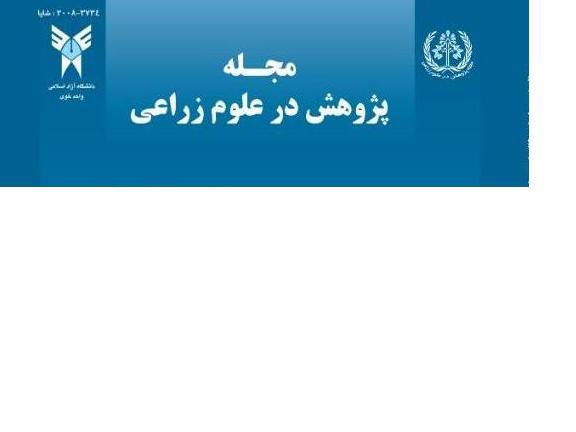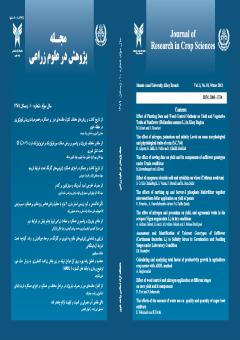اثر مقادير نيتروژن و پتاسيم بر عملکرد و صفات زراعي لوبيا چشم بلبلي در شرايط ديم
محورهای موضوعی : توليد محصولات زراعي
1 - گروه کشاورزي دانشگاه آزاد اسلامي واحد لاهيجان. ايران
کلید واژه: لوبيا چشم بلبلي, نيتروژن, پتاسيم, عملکرد,
چکیده مقاله :
استفاده از کودهاي مناسب و ميزان مصرف آن در گياهان زراعي، از جمله عوامل مهم در دستيابي به عملکرد بالا است. از اين جهت، به منظور بررسي تأثير کود نيتروژن و پتاسيم بر عملکرد و اجزاي عملکرد گياه لوبيا چشم بلبلي، آزمايش فاکتوريل در قالب طرح بلوک هاي کامل تصادفي در سه تکرار، در شهرستان آستانه اشرفيه در سال زراعي 1388 اجرا گرديد. در اين تحقيق کودهاي نيتروژن خالص (از منبع اوره) و پتاسيم خالص (از منبع کلرور پتاسيم) در سه سطح 0، 30 و60 کيلوگرم در هکتار انتخاب شدند. نتايج تحقيق نشان داد که اثر متقابل کود نيتروژن و پتاسيم در مقادير کودي30 کيلوگرم نيتروژن و30 کيلوگرم پتاسيم در هکتار، با عملکرد دانة 1555 کيلوگرم در هکتار بیشترین مقدار بود. همچنين تيمارهاي کودي نيتروژن و پتاسيم بر صفات عملکرد بيولوژيک، شاخص برداشت، وزن صد دانه، تعداد غلاف در گياه، طول غلاف، ارتفاع بوته و تعداد دانه در گياه در سطح احتمال يک درصد معني دار شد. ضرايب همبستگي ساده صفات مورد بررسي نشان داد که عملکرد دانه با صفات عملکرد بيولوژيک، شاخص برداشت، عملکرد غلاف، تعداد غلاف در گياه، تعداد دانه در گياه، تعداد دانه در غلاف و ارتفاع بوته داراي همبستگي مثبت و معني دار بود، ولي بين عملکرد دانه و وزن صد دانه همبستگي معني دار مشاهده نشد.
The use of appropriate fertilizer and its consumption in the crops, is of important factors in achieving high performance in the product. In order to investigate the effect of nitrogen and potassium fertilizer on yield and yield components of cowpea, an experiment was carried out in a factorial randomized complete block design in 2009, with 3 replications at Astaneh Ashrafiyeh, in East Guilan Province. The factors included nitrogen fertilizers 0, 30 and 60 (kgN/ha) and potassium fertilizers 0, 30 and 60 (kgK/ha). Interactions of nitrogen and potassium fertilizer showed 30 (kgN/ha) and 30 that (kgK/ha) with grain yield of 1555 (kg/ha) was the highest. The nitrogen and potassium fertilizers had significant effect on total biomass, harvest index, seed weight, and number of pods per plant, pod length, plant height and seed numbers per plant. simple correlation showed that grain yield had significant positive correlation with total biomass, harvest index, pod yield, number of pods per plant, seeds per pod and plant height, but significant correlation was no observed between seed yield and 100 seed weight.
Anonymous. 2005. Database and Agriculture Statistics Guilan province.
Anuadurai, K. and S. P. Palaniappan. 1994. Effect of potassium on yield, oil content, and nutrient uptake of sunflower. Physiologia Plantarum, 95(1): 11-18.
Davoodi, M.H., 2007. Nutrient Macro Elements Deficiency Symptoms in Field Crop. Agriculture Education publication, 144 pp. (In Persian).
Entesari, M., J. Khayrabi, A. Farshi, N. Haydari, M. Alaei, and zh. Vaziri. 2007. Water use efficiency in greenhouse cultivation. Iranian National Committee on Irrigation and Drainage Publications. Publication Number: 111. 180 pp. (In Persian).
Geetha, V. and K. Varughese. 2001. Response of vegetable cowpea to nitrogen and potassium under varying methods of irrigation. College of Agriculture, Vellayani 695522, rivandrum, India. Journal of Tropical Agriculture 39: 111-113.
Gilbert, N.W., and T.C. Tucker. 1987. Growth yield and yield components of sunflower as affected by source, rate and time of application of nitrogen. Agron. 49: 54-56.
Glas, K. and F. Kassel. 1988. Fertilizing for high yield and quality of sunflower. International potash institute (IPI). Worblaufen, Bern. Switzerland.
Huber, D.M. and D.C. Arny. 1985. Interactions of Potassium with Plant Diseases. In Potassium in Agriculture; Munson, R.D., Ed.; ASA, CSSA, and SSA: Madison, WI. 467–488.
Jahansooz, M., M. Naghavi, and A. Taleei. 2006. Determine the relationships between different traits in cowpea cultivars. Journal of Agricultural Sciences. Number1.Twelve year. 143-149. (In Persian).
Jeranyama. P. and R.R. Harwood. 2000. Realy intercropping of sunnhemp and cowpea into a Small holder Maize system in Zimbabwe. Agron. J. 92:239-244.
Johnston, A.E., Barraclough, PB, Poulton PR. and CJ, Dawson. 1998. Assessment of some spatial variable soil factors limiting crop yield. Proceeding No. 419. The International Fertilizer Society, York, UK, 48 pages.
Koocheki, A. and G. Sarmadnia, 1999. Physiology of Crop Plants. Publication of Mashhad collegiate Jehad. 400 pp. (In Persian).
Lopez, F. B. and C. Johanson. 1994. Limitation to seed yield short duration pigeon pea under water stress. Filed Crop Res. 36: (2). 95-102.
Marschner, H. 1995. Mineral nutrition of higher plants. In: Marschner, H.: Function of mineral nutrients: Microelements. Pp. 313–324. 2nd edition, Academic Press Inc., London.
Mohammadi, M. 2006. Pedology Agriculture. Publications Sepehr publishing center. (First edition). 245 pp. (In Persian).
Richardson, M.D. Croughan, S.S. 1989.Potassium Influence on Susceptibility of Bermudagrass to Helminthosporium cynodontis Toxin. Crop Sci. 29. 1280-1282.
Sabokdast, M. and F, Khiyalparast. 2007. Study the relationship between yield and yield components in 30 varieties of beans (Phaseolus vulgaris L). Journal of Science and Technology of Agriculture and Natural Resources. Number forty-second. Eleventh year. 123-133. (In Persian).
Shinde, S.V., K. Naphade, S.K. Kohale and G.R. Fulzele. 1993. Effect of varying levels of potash on seed and yield of sunflower. Res. J. 17:31-32.
Singh, B. B, D. R. Mohar and K. E. Dashiell. 1997. Advancess in cowpea researches.IITA- JIRCAS, Ibadan, Nigeria.

